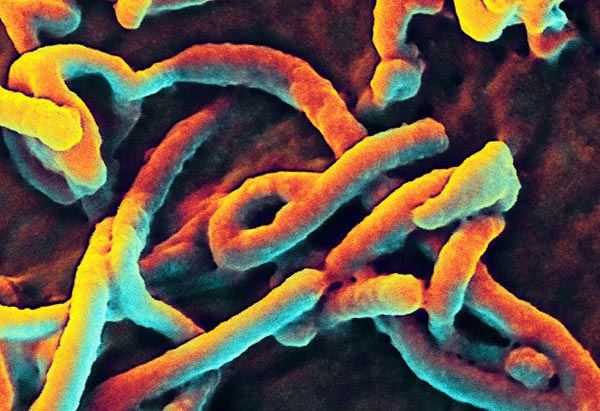Rapid and Durable Protection Against Ebola Virus With New Vaccine Regimens

Scanning electron micrograph of Ebola virus budding from a cell (African green monkey kidney epithelial cell line). Credit: NIAID
WHAT:
One shot of an experimental vaccine made from two Ebola virus gene segments incorporated into a chimpanzee cold virus vector (called chimp adenovirus type 3 or ChAd3) protected all four macaque monkeys exposed to high levels of Ebola virus 5 weeks after inoculation, report National Institutes of Health (NIH) scientists and their collaborators. The ability of the ChAd3 Ebola virus vaccine to elicit rapid protection in monkeys is notable as the world health community battles an ongoing Ebola virus disease outbreak in West Africa. While the protective effects of the single shot waned over time, two out of four inoculated animals were protected when challenged with Ebola virus 10 months after vaccination.
The research team, headed by Nancy J. Sullivan, Ph.D., of the National Institute of Allergy and Infectious Diseases Vaccine Research Center, also demonstrated increased levels of durable protection using an additional vaccine. They inoculated four macaques first with the ChAd3 Ebola vaccine, then 8 weeks later with a booster vaccine containing Ebola virus gene segments incorporated into a different vector (a poxvirus). Ten months after the initial inoculation, four out of four animals that received both shots were fully protected from infection with high doses of Ebola virus, demonstrating that the prime-boost regimen resulted in durable protection.
The research team included scientists from Okairos, a Swiss-Italian biotechnology company now part of GlaxoSmithKline, and the U.S. Army Medical Research Institute of Infectious Diseases. The experimental ChAd3 Ebola vaccine used in these non-human primate studies is the same one currently being tested in an early-stage human clinical trial at the NIH in Bethesda, Maryland.
ARTICLE:
DA Stanley et al. Chimpanzee adenovirus vaccine generates acute and durable protective immunity against ebolavirus challenge. Nature Medicine DOI:10.1038/nm.3702 (2014).
WHO:
NIAID Director Anthony S. Fauci, M.D., is available to comment on this research. Nancy J. Sullivan, Ph.D, Chief, Biodefense Research Section, Vaccine Research Center, NIAID is also available to comment.
CONTACT:
To schedule interviews, please contact NIAID Office of Communications, (301) 402-1663, niaidnews@niaid.nih.gov.
NIAID conducts and supports research—at NIH, throughout the United States, and worldwide—to study the causes of infectious and immune-mediated diseases, and to develop better means of preventing, diagnosing and treating these illnesses. News releases, fact sheets and other NIAID-related materials are available on the NIAID Web site at www.niaid.nih.gov.
About the National Institutes of Health (NIH): NIH, the nation's medical research agency, includes 27 Institutes and Centers and is a component of the U.S. Department of Health and Human Services. NIH is the primary federal agency conducting and supporting basic, clinical, and translational medical research, and is investigating the causes, treatments, and cures for both common and rare diseases. For more information about NIH and its programs, visit www.nih.gov.
NIH…Turning Discovery Into Health ®
Media Contact
All latest news from the category: Life Sciences and Chemistry
Articles and reports from the Life Sciences and chemistry area deal with applied and basic research into modern biology, chemistry and human medicine.
Valuable information can be found on a range of life sciences fields including bacteriology, biochemistry, bionics, bioinformatics, biophysics, biotechnology, genetics, geobotany, human biology, marine biology, microbiology, molecular biology, cellular biology, zoology, bioinorganic chemistry, microchemistry and environmental chemistry.
Newest articles

High-energy-density aqueous battery based on halogen multi-electron transfer
Traditional non-aqueous lithium-ion batteries have a high energy density, but their safety is compromised due to the flammable organic electrolytes they utilize. Aqueous batteries use water as the solvent for…

First-ever combined heart pump and pig kidney transplant
…gives new hope to patient with terminal illness. Surgeons at NYU Langone Health performed the first-ever combined mechanical heart pump and gene-edited pig kidney transplant surgery in a 54-year-old woman…

Biophysics: Testing how well biomarkers work
LMU researchers have developed a method to determine how reliably target proteins can be labeled using super-resolution fluorescence microscopy. Modern microscopy techniques make it possible to examine the inner workings…





















